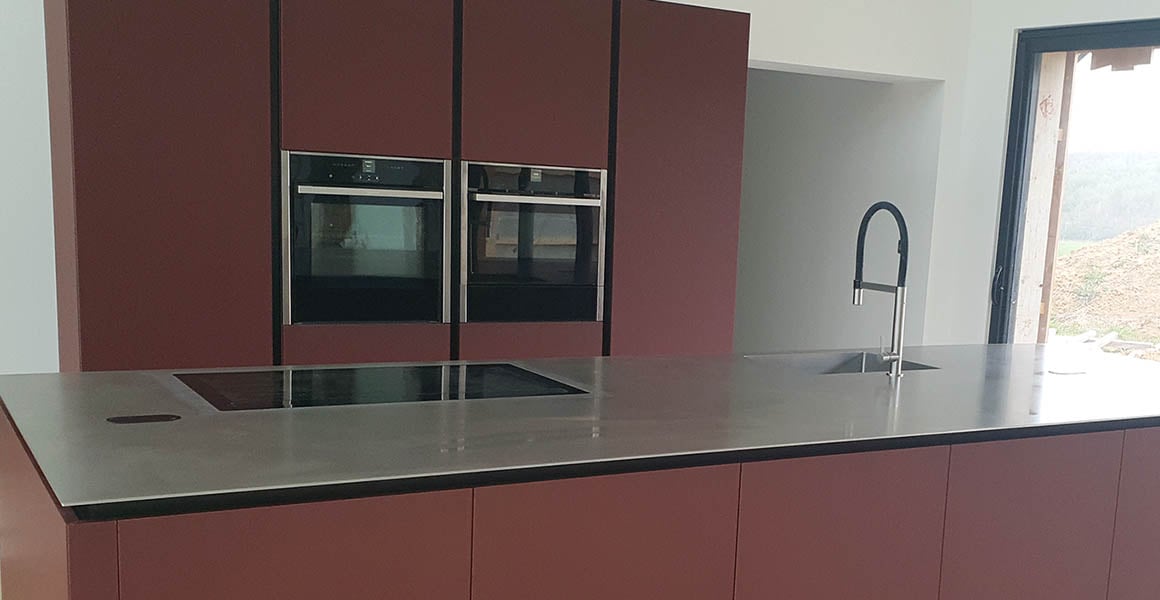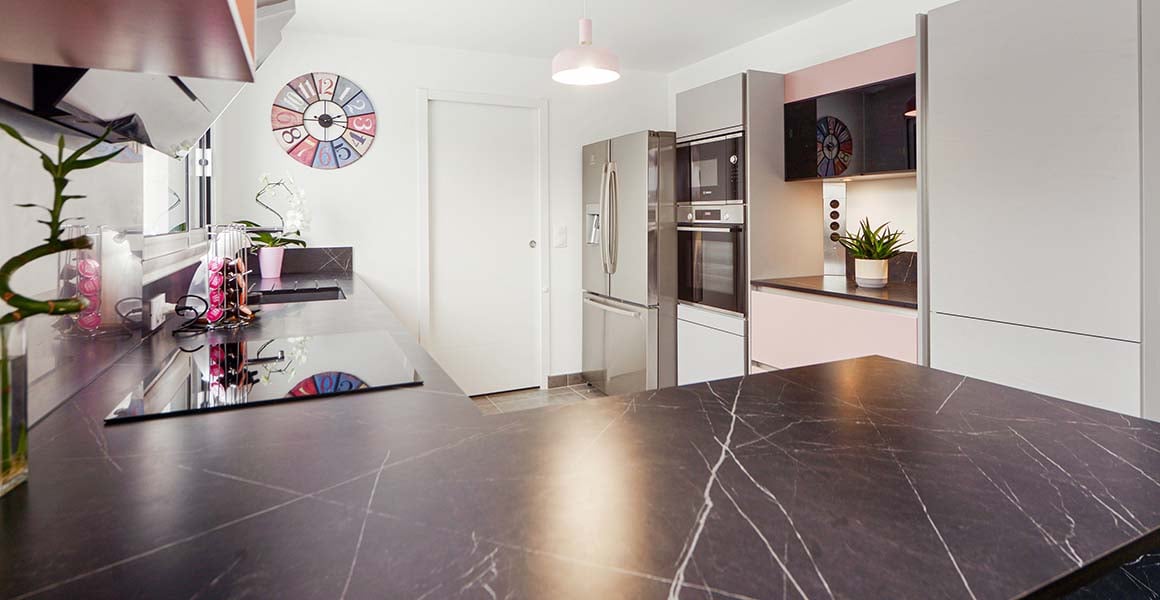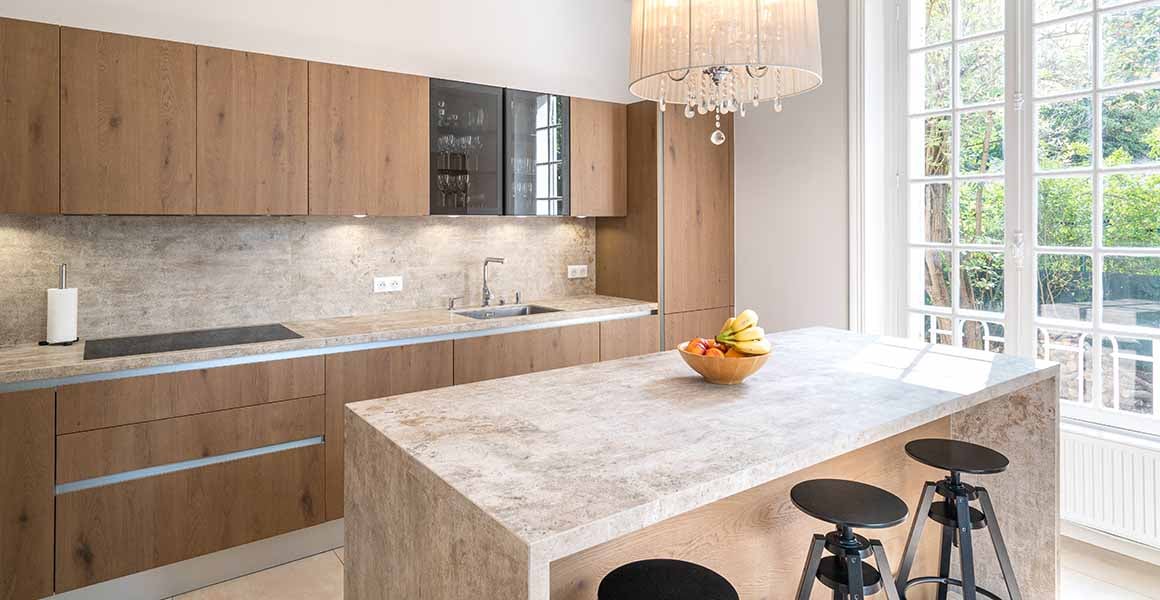There is a wide variety of worktops, with a host of different materials and prices. Whether you want the worktop for a professional kitchen or at home, it needs to be both heat and moisture resistant along with suiting your own style. So how do you choose the best worktop? We take a look at the materials to give you a clearer picture.
To help you imagine your future kitchen, we will give you a step-by-guide to the aesthetic advantages of each material and its resistance to moisture, heat and the kinds of knocks associated with kitchens. We will also point out any limitations of materials and how easy they are to maintain. You will then know what kinds of stone, wood or composite material to buy for a kitchen worktop that truly reflects your taste and lifestyle.
Affordable and reliable: the laminate worktop
The laminate worktop is the most common choice for kitchens. It has great resistance to knocks and scratches and is good value for money, which explains why it is so popular. Laminate has resistance to heat, moisture and grease, it is very easy to maintain.
Laminate can be made to look like wood, stone or concrete. For example; a slate-effect laminate, or one with a black polished concrete look, will give your kitchen a modern feel and create a wonderful textured effect. You might also opt for a terrazzo-style laminate to lend a bit of colour to a breakfast bar or open-plan kitchen.
Most laminate worktops sold are between 22 - 38mm thick. Another option is 60 mm, which creates a really sturdy effect. This works really well with imitation solid wood as it gives an impression of great solidity and authenticity – just the thing for kitchens in renovated houses. And unlike wooden worktops, laminate does not require any maintenance. A quick wipe with a sponge and it's nice and clean again.

Modern and totally transparent: the glass worktop
A glass worktop is made from toughened glass. Choosing a glass worktop makes the room appear bigger and brighter. Compared with other types of worktops, glass is fairly light and easy to install. It is sensitive to thermal shocks and prone to scratches, however, and cannot be exposed to temperatures above 120°. Glass does not like big impacts and may shatter or break soon after. As happens with phone screens or windscreens, glass does not like big impacts and may shatter or give way soon after. It is also really difficult to maintain glass, once it is scratched it is almost impossible to remove.
Fashionable and environmentally friendly: the wooden worktop
Across all types of kitchens, the wooden worktop is currently having its moment in the sun. This timeless material can be found in more and more kitchens as it helps create a warm atmosphere. There are numerous combinations for creating the perfect kitchen, whether you opt for an industrial style combining wood and black or something more contemporary combining wood and white. The choice of varnish or paint in particular will have a big impact on your kitchen’s aesthetic. The current trend is to keep more of a raw feel for wooden worktops and use a protective varnish specially suited to kitchens – in either a medium wood matt or colourless finish. This kind of varnish or natural oil will offer extra protection against grease stains and make the worktop easy to clean on a day-to-day basis.
When it comes to worktops, there are various types of wood available. Depending on the tree, the wood will have different essential properties. In terms of interior design, ‘wood’ covers a pretty broad range, including wood from Europe, exotic wood types, solid wood or laminated wood. Each type of wood is different and gives your kitchen a unique feel. Whether it’s beech, bamboo, teak, elm, ash or oak, to name just a few. A host of wood types are suitable for the kitchen, with prices varying widely too.
Unlike laminate, Some Solid wood worktops require extra maintenance. To help avoid stains, it is recommended to apply a special oil – designed for wood worktops – at least twice a year. This repeated application of oil will also protect your worktop from spots left by water and moisture, which can sometimes form near the sink.

A professional-looking kitchen with a stainless-steel worktop
For years now, the stainless steel worktop has been regarded as the preferred worktop for food professionals. These days, it can also be found in more and more kitchens in ordinary homes. One of the advantages with the stainless-steel worktop, despite its rather cold appearance, is how easily it fits into all kinds of decors and kitchen styles. For example, you can use it alongside glass, stone or even wood. It’s all about contrasting the coldness of stainless steel with the other kitchen units, or maybe using a backsplash or paintwork to lend some warmth to the room.
Stainless steel is heat-resistant. With this material, you don't have the fuss or worry of putting mats under everything. It also has the advantage of being waterproof and able to cope with detergents. The simplicity of design makes it a very popular choice. Stainless steel worktops come in a number of finishes such as satin, smooth or brushed. In terms of weak points, stainless steel may show clearly visible marks and scratches and is not very impact-resistant. Despite being easy to maintain, the stainless-steel worktop is somewhat fragile and prone to staining.

Natural stone for your kitchen worktop
The marble or granite kitchen worktop has a reputation for being both solid and aesthetically appealing. And while granite is an ideal choice for a durable and impeccable worktop, the marble worktop presents a more nuanced option.
Marble worktop
Instantly recognisable for its porous feel and characteristic patterns, the marble kitchen worktop features prominently in interior design magazines. Having said this, it should only be used for more decorative surfaces such as the backsplash in the kitchen.
Depending on the quality of stone used, a marble worktop can vary quite heavily in terms of price, even though the material is not really resistant to the acidity of foodstuffs or to cleaning products, heat and impact. The ceramic kitchen worktop with a marble effect represents a more economical and durable alternative for your home.
Granite worktop
Granite is an igneous rock from deep underground. Often confused with marble, this natural stone is becoming increasingly popular in kitchens for a really sophisticated designer look. The granite worktop is available in a wide range of colours including red, black, grey, white, yellow and many other shades, making it suitable for all styles of kitchens and all tastes.
This rather dark igneous rock is a natural stone with some extraordinary benefits for the kitchen. Thanks to the great skills of worktop fabricators, custom marble worktops are almost the standard; basins can be made from the same stone, drainer grooves and cut outs can be added with ease. With the right fabricator the possibilities are almost endless.
The granite worktop lasts a long time and is easy to maintain. It can withstand high temperatures(+ 300°), scratches, different types of impact and the various stains you might expect in a kitchen. It is also resistant to detergents. This worktop can be a little bit more expensive than some, but the pros massively outway the cons. As pointed out already, it offers great resistance so does not require any protection. Just the thing when you’re taking something out of the oven – no need for any mats!

Artificial and composite stone types: quartz, polished concrete, ceramics, etc.
With a kitchen worktop made from artificial stone, the really big advantage is ease of maintenance. These worktops share a lot of the same advantages as Granite and look fantastic in smaller kitchens.
The made-to-measure worktop in quartz, ceramic and other types of composite stone offers a really adaptable surface. You then have the option to integrate rounded, grooved or hollowed-out edges into kitchen plans, as well as a hob and integrated drainer, a central island or made-to-measure spaces for each individual appliance.
Quartz worktop
Quartz is a composite stone that came onto the scene in the ‘90s. It consists of 90% natural quartz mixed with a coloured resin. Synonymous with high-end kitchens, the quartz worktop is pretty resistant to stains, scratches, impact and is really easy to maintain.
Quartz is so popular because this particular stone suits virtually any style of kitchen, with a wide choice of colours and finishes available (smooth, rugged, gloss or satin). Quartz goes really well with other materials used in kitchens, such as wood, stainless steel or metal. But the quartz worktop does have a few disadvantages.
One of the main drawbacks with this material is its relative fragility. It is very sensitive to heat. The quartz worktop becomes fragile at temperatures of 150°C and above, so you always need to put a mat under things to avoid damaging the worktop.

Polished concrete worktop
Understated and resistant, polished concrete is a mixture of sand, clay, water and lime. Resin and pigments are then added to bind it all together and give it a unique finish. It is a popular choice as a decorative coating and can be found in pretty much any room in the house. Kitchens, bathrooms and living rooms are all succumbing to its relentless appeal. The advantages of a polished concrete worktop are the design possibilities, the potential to create great-looking kitchens and the fact it is waterproof.
Polished concrete is really easy to maintain and perfectly suited to a room, like the kitchen, which tends to see a lot of moisture. It is highly resilient, but does require a small amount of maintenance to keep it in excellent condition over the years. As with any worktop, polished concrete has a few disadvantages such as its sensitivity to heat and impact, as well as being prone to scratches.
Please note: the concrete worktop is always made by hand on site.

Ceramic worktop
Ceramics are materials made from clay and natural stone and are mainly used for worktops in Italy and Spain. They tend to be created as large pieces and are not very thick, making them one of the most resistant and hygienic materials that can be used in a kitchen.
The 2 main plus points are their thinness and ability to withstand high temperatures. In terms of interior design, the ceramic worktop is gradually replacing the tiled worktop. The joins in the tiled worktop tended to be visible and become damaged or yellow over time. The ceramic worktop is resistant to staining, heat, grease, nicks and UV rays. It is created as a single piece and can be cut out for built-in sockets and a hob. The ceramic worktop can be expected to stand the test of time, Why not choose a ceramic worktop for a kitchen area outside? Ceramics are not porous and cope well with all kinds of stains or corrosive products
In terms of aesthetics, kitchen areas in ceramics are available in matt, gloss or velvety finishes. Ceramics are often used as an alternative to marble or quartz and offer a much higher-quality look than laminate or melamine worktops.
Another advantage of ceramics, as a material, is how imaginative you can be with them. You can easily use them to create a single, uniform piece instead of the backsplash and worktop. Ceramics can even be used to adorn the outside of the various surrounding units, as well as the fridge, for a uniform look in your kitchen.

Other artificial resins and stone types for a durable kitchen worktop
The synthetic resin worktop is made from a mix of powdered minerals and acrylic resin suited to preparation surfaces in kitchens and certified for contact with food. This worktop is also resilient as it is both waterproof and non-porous. With it having no joints, it is more hygienic and easier to maintain. For example; you can order a one-piece resin worktop with a sink and drainer cut out of the material or even install one in a U-shaped kitchen with no visible joints. This worktop is popular for its aesthetic appeal, with a matt or satin finish and a wide range of colours to suit all tastes. The ‘artificial stone’ resin worktop offers a monolithic look, which is particularly suited to a modern white kitchen or an island in an open-plan kitchen.
The synthetic resin worktop offers good value for money as synthetic resin is a high-end material that is designed to last for 15 to 20 years. As with any worktop, it has a few drawbacks. Synthetic resin is slightly more prone to scratches and less resistant to heat above 180°C, so be sure to put your dishes on matts and racks instead of this worktop.











-1.jpg)







